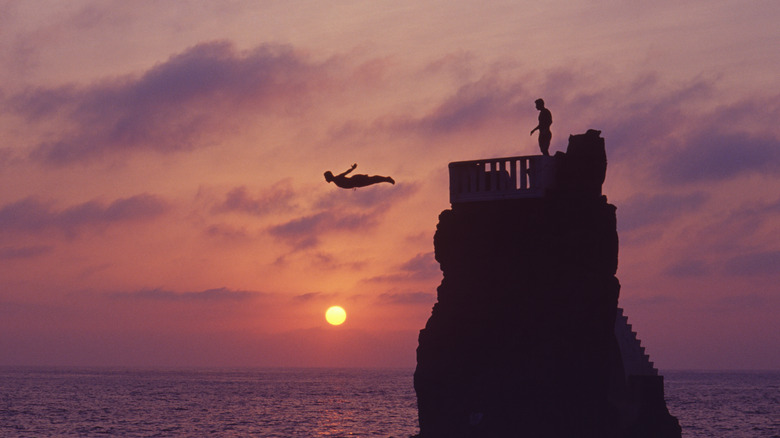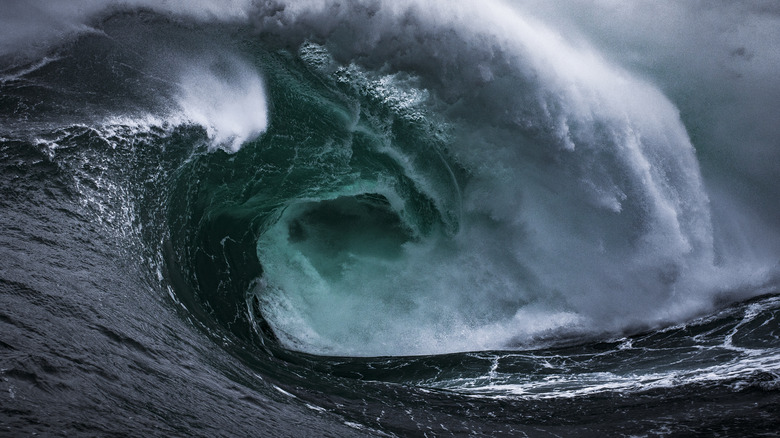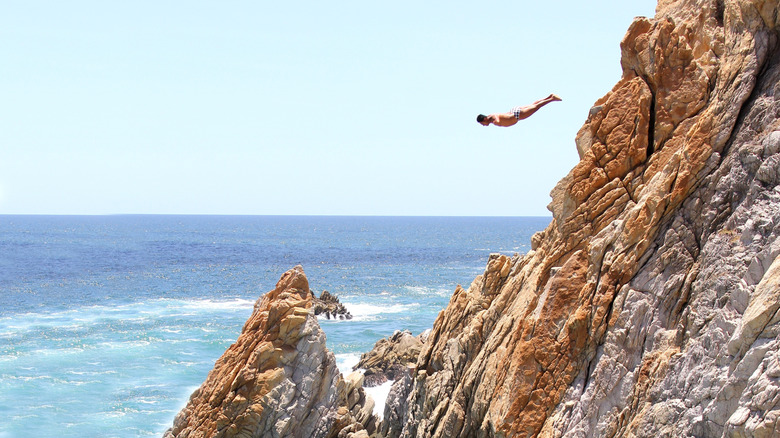Here's How High You Can Fall Into Water Before It Feels Like Concrete
It's the type of statement that you might remember from grade school, or a tidbit tossed around by someone at a party who's trying too hard to not be dull: "Dude, did you know if you jump into water and, like, you're really high up it'll feel like concrete? You'd totally die." Cue the protestations, rambling analyses, discussions about diving feet first or head first, how high you'd have to be, if you could survive a water crash in a plane, etc. In some ways, all such lines of inquiry are best left unknown if only to give people something to talk about. But since we're all about spoiling mysteries: How high do you have to be before a water landing feels like concrete? It depends.
That's an anticlimactic answer, we know. But, there are a lot of variables to take into account. First off, different objects have different terminal velocities: the maximum velocity reached when falling due to gravity. The mass, shape, and dimensions of an object determine its terminal velocity because those factors influence drag force — the force exerted opposite to a falling body (think of a parachute slowing down a fall here). Then there's the entry into water, like entering vertically vs. belly-flopping. And then, there's wind and water to take into account.
But all factors considered, the Federal Aviation Agency (FAA) placed the upper limit of human survivability (in terms of velocity) at 116 feet/second — but only if you go in feet first. That's about 186 feet high. We can safely say that if someone dies when landing in water, it probably feels like concrete.
Terminal velocity and drag force
Parachutes: How do they even work? Think of dropping a bowling ball vs. dropping a feather (another elementary school experiment). Gravity doesn't change for either, but the mass, shape, and dimensions of each object determine its terminal velocity — the maximum speed that the object will ever reach on its descent to Earth. A parachute has a massive surface area that increases drag forces, which reduces terminal velocity and slows a person's descent. But without a parachute, terminal velocity for a human body is about 120 miles per hour or 176 feet per second. But a person doesn't even need to reach terminal velocity to go kersplat on the water.
In the way that all objects have different terminal velocities, all animals have different "critical incident velocities," aka, velocities that kill on impact. The aforementioned Federal Aviation Administration (FAA) study mentions that mice have died in impact with water at 118 feet/second and guinea pigs at 99 feet/second (let's not ask how this data was obtained). In general, it seems like bigger animals tend to die on impact from lower heights.
And humans? They've died at 94 feet/second (about 149 feet high), which is 22 feet under the maximum survivable height of 116 feet/second (186 feet high). It only takes about three seconds of falling to reach this latter speed. The good news is that in those three seconds, you've got a chance to survive, provided you enter the water in a certain way.
Orientation on impact is the most critical factor
We all know that belly flops hurt, right? This is like the surface area of a parachute, where a belly flopper presents a greater surface area to the substance in question. Splat, ouch, feels like concrete. In fact, the Federal Aviation Administration (FAA) says that body orientation — how you hit the water — is the single greatest factor influencing injuries and survival from high heights upon water impact. You want to go in feet first with arms over your head, which increases survivability by five to seven times.
This is because as your body penetrates water the water needs to be displaced at a rate commensurate with your velocity and dimensions. Otherwise, your body gets deformed, compressed, and injured. Going in feet first helps do this, which means a feet-first landing from a high height will hurt less than another kind of landing. The FAA reports that landing laterally (on your side) requires the lowest velocity and height to be injured and die, followed by prone (on your stomach), supine (on your back), head-first, and then feet-first. Common injuries in feet-first or butt-first entry include damaged vertebrae. Lateral, prone, and supine entry produced internal hemorrhaging, which more often kills. Weirdly enough, feet-first water landings don't damage the feet or ankles — unlike landing on actual concrete.
Age is the next most important survivability factor, with ages 20 to 36 having the greatest survival from higher heights. Better physical condition increases survivability, too, as well as protective clothing.
Calm vs. rough wind and water
There's another set of factors that play a role in how high you'd have to fall before water feels like concrete: wind and water conditions. The Federal Aviation Administration (FAA) study mentions that direction and speed matter. Thinking of our discussion of parachutes and terminal velocity, the reader can imagine that wind can either accelerate or decelerate the plummet to Earth, or sort of blow you to the side. It might also alter your orientation, which affects how you enter the water. And if you don't enter feet-first, it's much more likely to be lights out and kersplat on contact. And if the wind is blowing faster, all of these effects get exaggerated even more.
Wind calmness connects to water calmness. If wind is light or minimal, it's likely that water will be calm. But, calmer water is more likely to produce a stronger impact because of greater surface tension. Rough or choppy water contains little air pockets that allow for easier water displacement if you fall in, which means a weaker impact. But of course, rougher water means it's harder for someone to surface, swim, and survive after entry (which admittedly is a different story entirely).
That being said, one discussion on Physics Stack Exchange says that surface tension is less relevant than you might realize, and doesn't greatly affect impact. Another discussion on Physics Forums similarly says that the difference between calm and rough water doesn't really matter all that much.
How cliff divers and Olympic divers do it
Finally, we look to people who fall from the highest human heights possible and survive: cliff divers and Olympic divers. You'll notice in videos of cliff divers on Red Bull Cliff Diving that each and every diver enters the water feet-first. Plus, they're all in obviously excellent physical condition. These divers are also diving from a very specific height of 88 feet, well below the death-causing height of 149 feet that the Federal Aviation Administration (FAA) cited. They also reach speeds of 54 miles per hour, which is under the FAA's maximum death-causing velocity of 116 feet per second (79 miles per hour). So no problem, right? Besides all the bone-shattering rocks.
And then there are Olympic divers. Olympian Kassidy Cook told the Los Angeles Times, "People have no idea. When you hit the water, it's as hard as concrete for a split-second before you break through." She and others describe how physically brutal it is to dive from a high height into water because of all the reasons cited in this article. Medical director for USA Diving John Locke said, "This is a contact sport. It puts a lot of negative forces on your body that you have to overcome to be an Olympian." This is why divers learn a little trick to break the water's surface tension just before they land, even if only to ease up the entry a little. But not even an Olympic diver can survive a fall into water at terminal velocity, or even before it.




